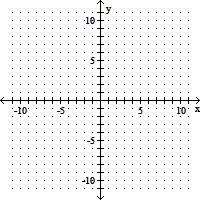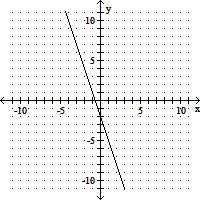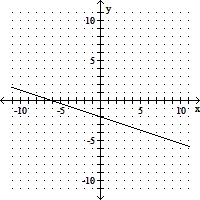Solve the problem.The number of periods needed to double an investment when a lump sum is invested at 11%, compounded semiannually, is given by n =  . Find n, rounded to the nearest tenth.
. Find n, rounded to the nearest tenth.
A. 15.9 periods
B. 17.9 periods
C. 12.9 periods
D. 8.9 periods
Answer: C
You might also like to view...
Solve. Use a calculator to approximate the irrational solutions to three places.(x + 1)2 = 13
A. 2.606 B. ±3.742 C. 2.606, -4.606 D. ±3.464
Graph the line described.Through (6, 0); m = - 

A. 
B. 
C. 
D. 
Solve the system by the method of your choice. Identify systems with no solution and systems with infinitely many solutions, using set notation to express their solution sets.3y = 21 - 4x2x = 27 - 3y
A. {(3, -11)}
B. {(-3, 11)}
C. { 4x + 3y = 21 }
4x + 3y = 21 }
D. ?
Use a calculator to graph the rational function in the window indicated. Use the graph to (a) give the x- and y-intercepts, (b) explain why there are no vertical asymptotes, (c) give the equation of the oblique asymptote, and (d) give the domain and range.f(x) =  ; [-6, 6] by [-3, 3]
; [-6, 6] by [-3, 3]
A. (a) x-intercepts: (-4, 0), (-1, 0), (1, 0); y-intercept:  ;
;
(b) The denominator has no real zeros because the discriminant, -28, is negative.;
(c) y = -  x -
x -  ;
;
(d) The domain and range are both (-?, ?).
B. (a) x-intercepts: (-8, 0), (-2, 0), (2, 0); y-intercept:  ;
;
(b) The denominator has no real zeros because the discriminant, -28, is negative.;
(c) y =  x +
x +  ;
;
(d) The domain and range are both (-?, ?).
C. (a) x-intercepts: (-4, 0), (-1, 0), (1, 0); y-intercept:  ;
;
(b) The denominator has no real zeros because the discriminant, -28, is negative.;
(c) y = -  x +
x +  ;
;
(d) The domain and range are both (-?, ?).
D. (a) x-intercepts: (-8, 0), (-2, 0), (2, 0); y-intercept:  ;
;
(b) The denominator has no real zeros because the discriminant, -28, is negative.;
(c) y =  x -
x -  ;
;
(d) The domain and range are both (-?, ?).